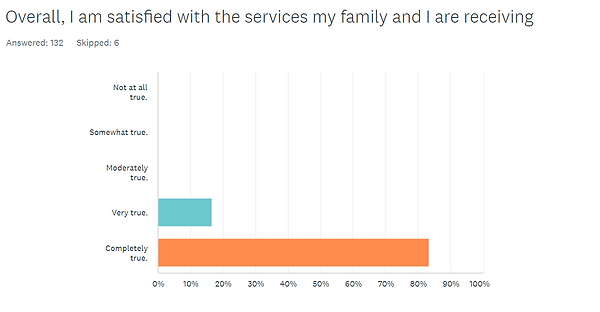
Patient and Family Treatment Outcomes
New Horizons measures its results by obtaining parent rated scores both before and after treatment on the Youth Outcomes Questionnaire (YO-Q 2.1; a measure of symptoms and behavior) and the Child & Adolescent Family Functioning Inventory (CAFFI; a measure of how well families communicate, solve problems together,
and more).
Outcomes
Both the YO-Q 2.1 and the CAFFI produce a Total Score as well as individual subscale scores, all of which would be expected to improve (decrease) between the start of treatment and the end.
We perform two statistical tests to determine if the average decrease in scores is more than what would be expected by chance (statistical significance using a paired-samples t-test) and how large the treatment effect is (as measured Cohen's d).
Here's the bottom line:
The kids who complete IFFT show substantial clinical improvement: Significant reductions in mental health symptoms and problem behaviors, and far better communication and closeness with family members.

Youth Outcomes Questionnaire
Version 2.1
The above graph shows for the 30 most recent families that completed treatment, the average patient (child) YO-Q Total Score at the start of treatment was 101, which is much higher than the average score for kids in outpatient programs (78.7). That’s not unexpected given that the kids we treat generally have long-standing, serious challenges. By the end of treatment, the average score dropped to only 43. Note the YO-Q has a clinical cutoff of 47, meaning that an average score of 43 is below the cutoff and indicates a lack of clinical distress. The Total Score was reduced on average to a point of statisitcal significance and with a very large treatment effect.
The YO-Q also has five subscales (Emotional Distress, Relationship Problems (with parents and peers), Social Problems, Behavioral Challenges, and Critical Items (e.g. self-harm, suicidal thoughts, substance abuse, psychosis, etc.). Each of these scores was also reduced on average to a point of statistical significance and all with a very large treatment effect.
Child and Adolescent Family Functioning Inventory
For the 30 most recent families who completed treatment, the average CAFFI Total Score at the time treatment began was 91.5 and by the end of treatment the average score dropped to 50.4. Note the Total Score on the CAFFI for families that aren’t in clinical distress is 50.0 or less, so on average after IFFT most familes were no longer experiencing clinical distress.
The CAFFI also has subscales (Ability to Solve Problems, Managing Stress and Conflict, Closeness and Connection, and Effective Communication). Each of these scores was also reduced on average to a point of statistical significance and all with a very large treatment effect.

Overall Family Satisfaction
New Horizons Child and Family Institute asks families to periodically evaluate our work in order for us to know if we are on the right track and meeting their needs.

The above graph shows the most recent responses to the statement, "Overall, I am satisfied with the services my family and I are receiving" (138 of the most recent responses in total). As can be seen, 100% of our families indicated that statement is completely true (83.3%), or very true (16.7%).



